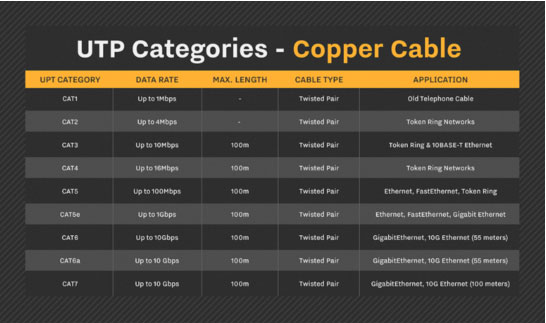
Unshielded twisted pair
UTP cable iscertainly the most popular type of network cable by far around the world. UTPcable is used not only for networking, but also for the traditional telephone(UTP-CAT1). There are six different types of UTP categories and, depending onwhat you want to achieve, you would need the appropriate type of network cable.UTP-CAT5e is the most popular UTP cable; it replaced the old coaxialcable that was unable to keep up with the constantly growingneed for faster and more reliable networks.
Characteristics of UTP categories
The characteristics of UTP are very good and make it easy to work with,install, expand and troubleshoot. Now, we are going to look at the differentwiring schemes available for UTP, how to create a straight-through UTP cable,rules for safe operation and a lot of other interesting information.
So, let's have a quick look at each of the UTP categories availabletoday:
These categories specify the type of copper wire -- most telephone andnetwork wire is copper -- and jacks. The number (1, 3, 5 and so on) refers tothe revision of the specification and, in practical terms, to the number oftwists inside the wire -- i.e., to the quality of connection in a jack.
About the popular Cat5 & Cat6 & Cat 7:
CAT3, CAT4 and CAT5 cables are four pairs of twisted copper wires; CAT5 hasmore twists per inch than CAT3. Therefore, CAT5 can run at higher speeds andgreater lengths. The twist effect of each pair in the cables ensures anyinterference presented or picked up on one cable is cancelled by the cable'spartner that twists around the initial cable. CAT3 and CAT4 are both used fortoken ring networks -- where CAT3 can provide support of a maximum 10 Mbps, while CAT4 pushed thelimit up to 16 Mbps. Both categories have a limit of 100 meters.
The more popular CAT5 wire isnow replaced by the CAT5e specification that provides improved crosstalkspecification, allowing it to support speeds of up to 1 Gbps. CAT5e is the mostwidely used type of network cabling specification worldwide, and unlike thecategory cables that follow, it is very forgiving when the cable terminationand deployment guidelines are not met.
CAT6 wire was originally designed to support GigabitEthernet, although there are standards that will allow gigabit transmissionover CAT5e wire. It is similar to CAT5e wire, but contains a physical separatorbetween the four pairs to further reduce electromagnetic interference. CAT6 isable to support speeds of 1 Gbps for lengths of up to 100 meters, and 10 Gbpsis also supported for lengths of up to 55 meters.
Today, most new cablinginstallations use CAT6 as a standard; however, it is important to note that allcabling components -- jacks, patch panels, patch cords and the like -- must beCAT6-certified, and extra caution must be given to the proper termination ofthe cable ends.
In 2009, CAT6A was introducedas a higher specification cable, offering better immunization from crosstalkand electromagnetic interference.
Organizations performinginstallations using CAT6 cabling should request a thorough test report, using acertified cable analyzer, to ensure the installation has been performedaccording to CAT6 guidelines and standards.
CAT7 is a newer coppercable specification designed to support speeds of 10 Gbps at lengths of upto 100 meters. To achieve this, the cable features four individually shieldedpairs, plus an additional cable shield to protect thesignals from crosstalk and electromagneticinterference.
Due to the extremely high datarates, all components used throughout the installation of a CAT7 networkcabling infrastructure must be CAT7-certified. This includes patch panels,patch cords, jacks and RJ-45 connectors. The absence of CAT7-certifiedcomponents will degrade overall performance and thus lead to the failure of anyCAT7 certification tests -- for example, using a cableanalyzer -- since CAT7 performance standards are most likely not to be met.Today, CAT7 is usually used indatacenters for backbone connections between servers, network switches andstorage devices.
Editor:Oceania
